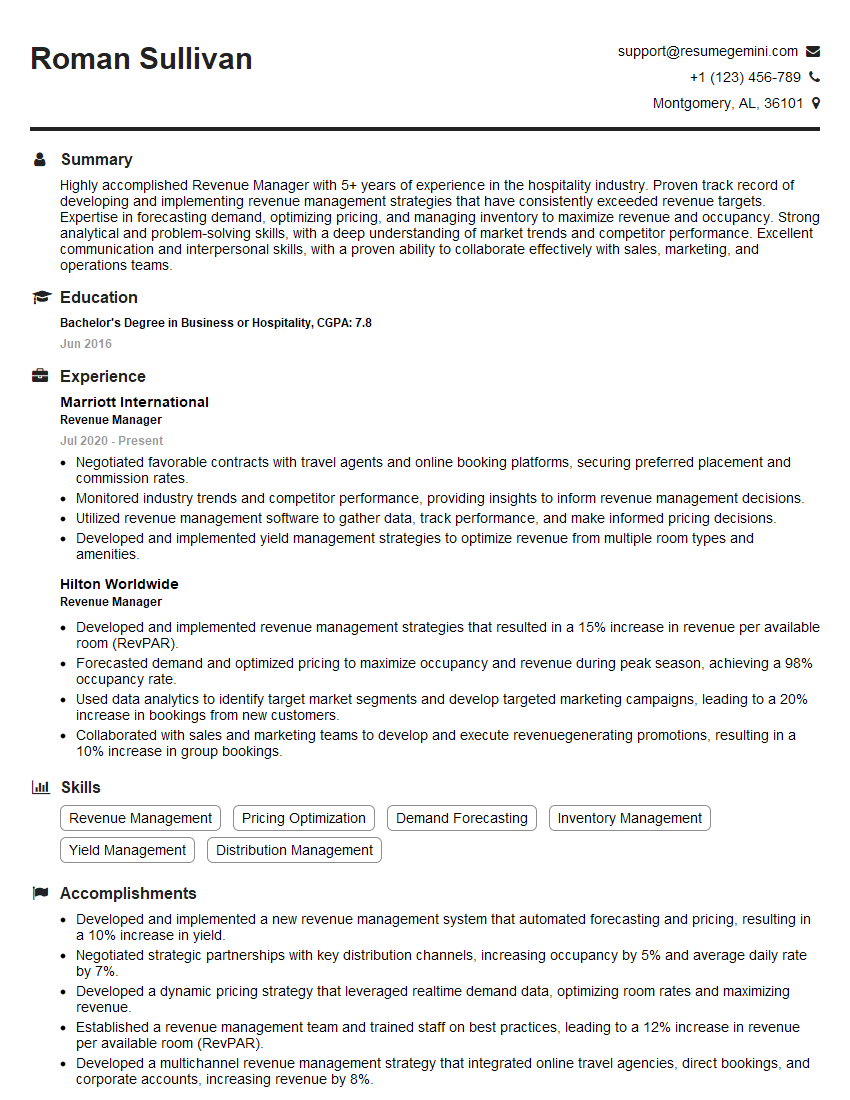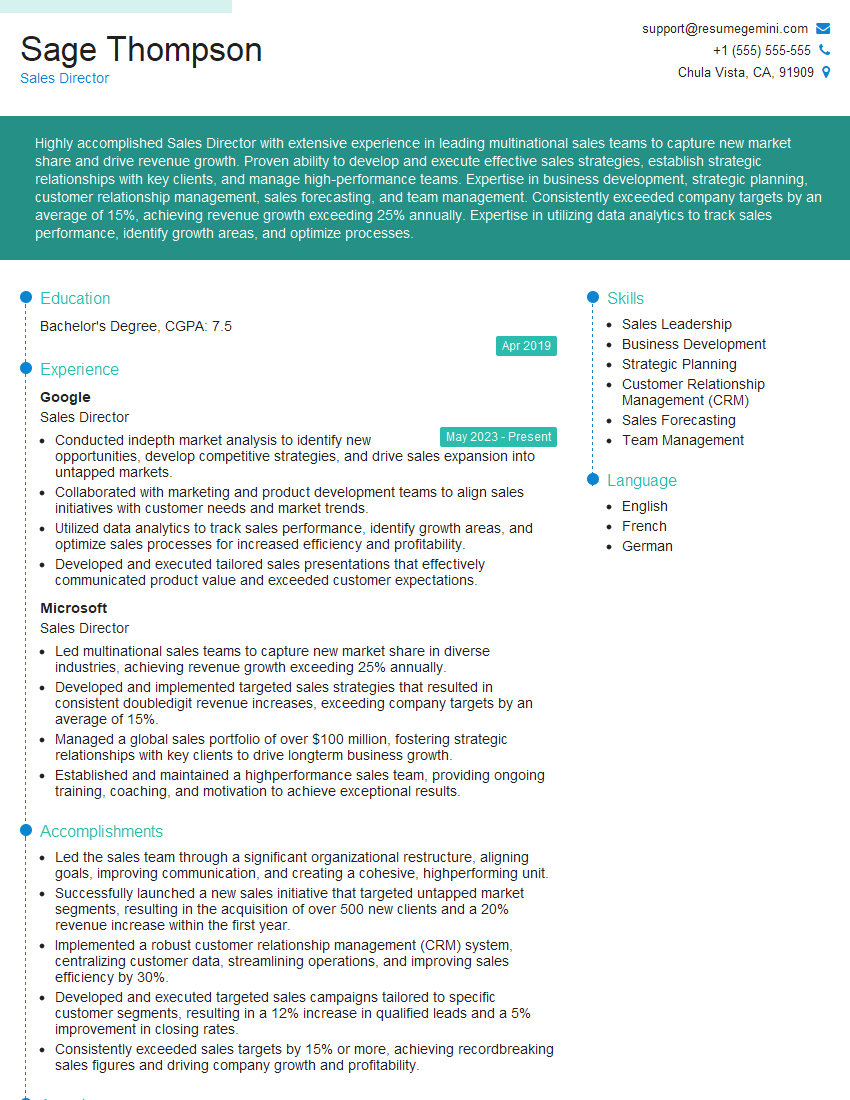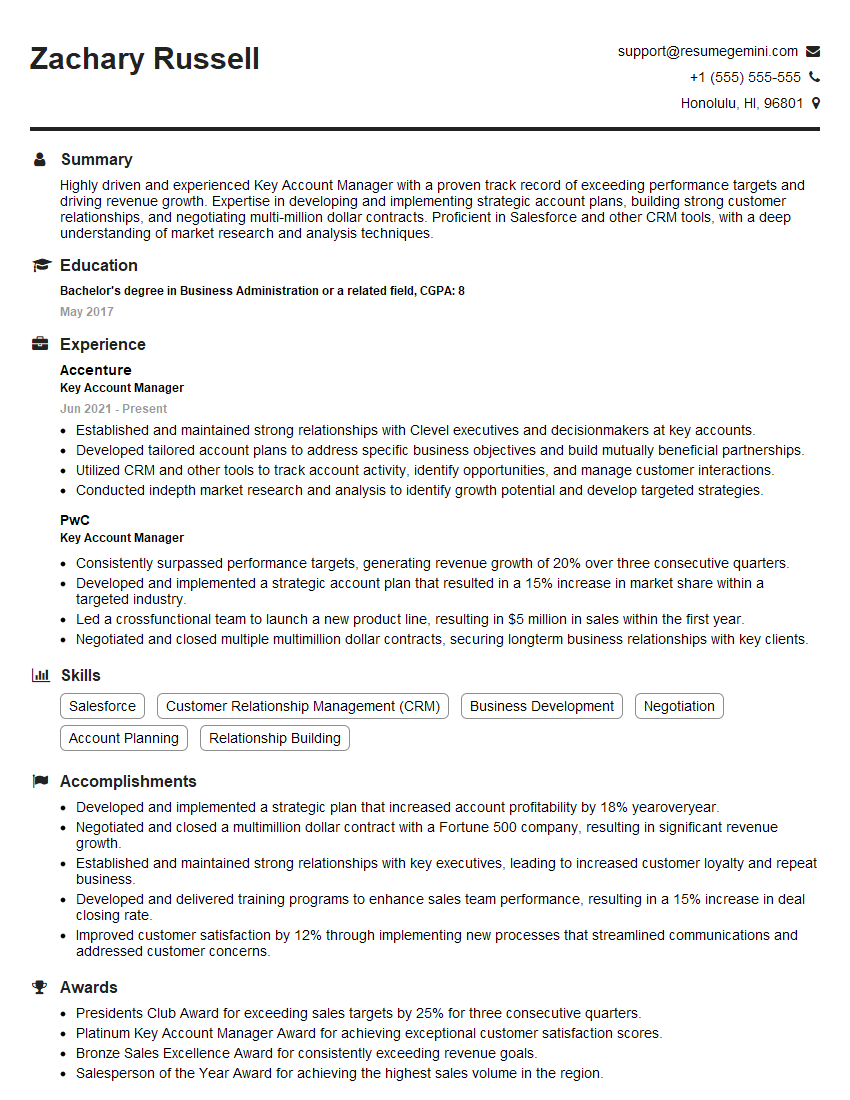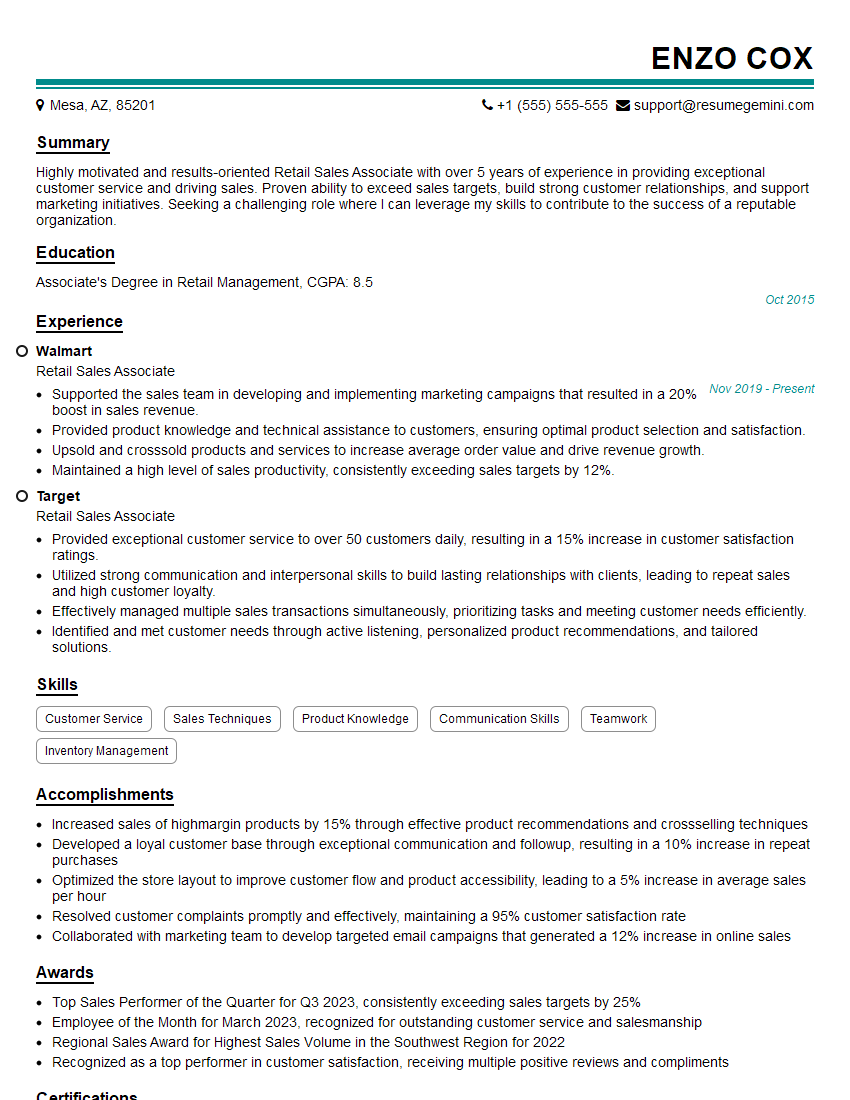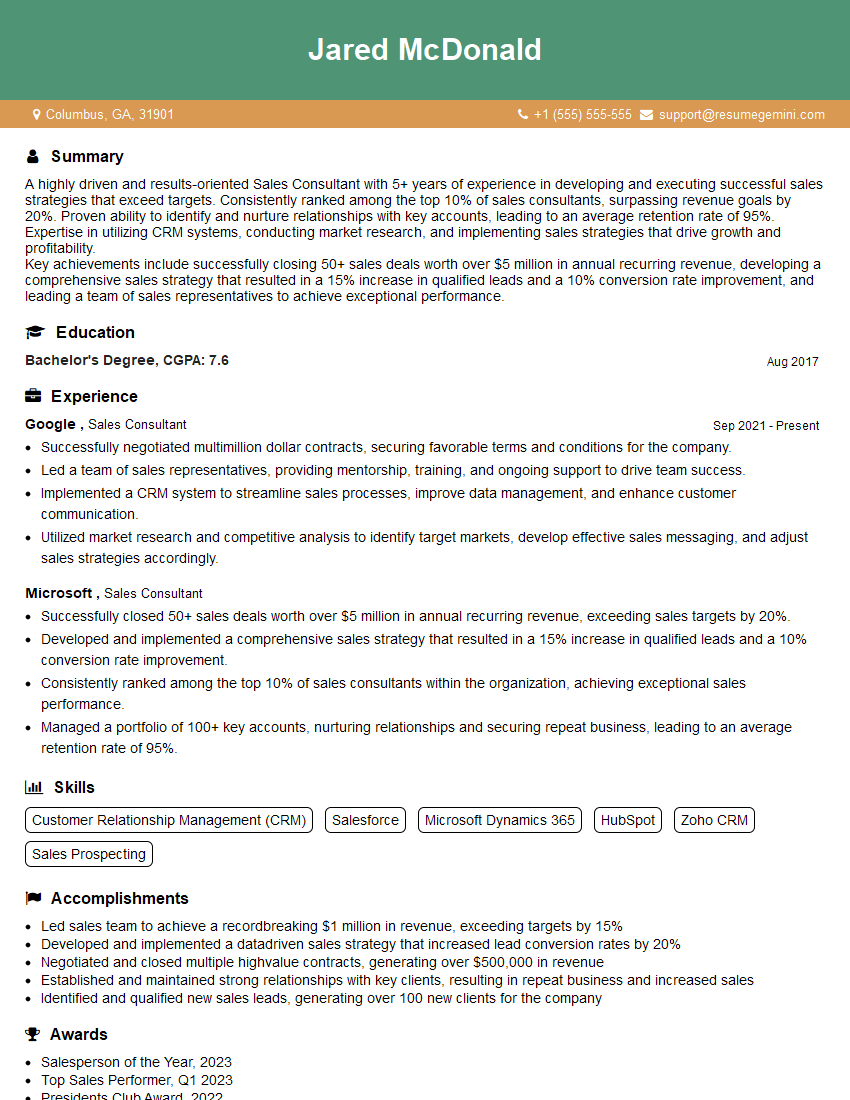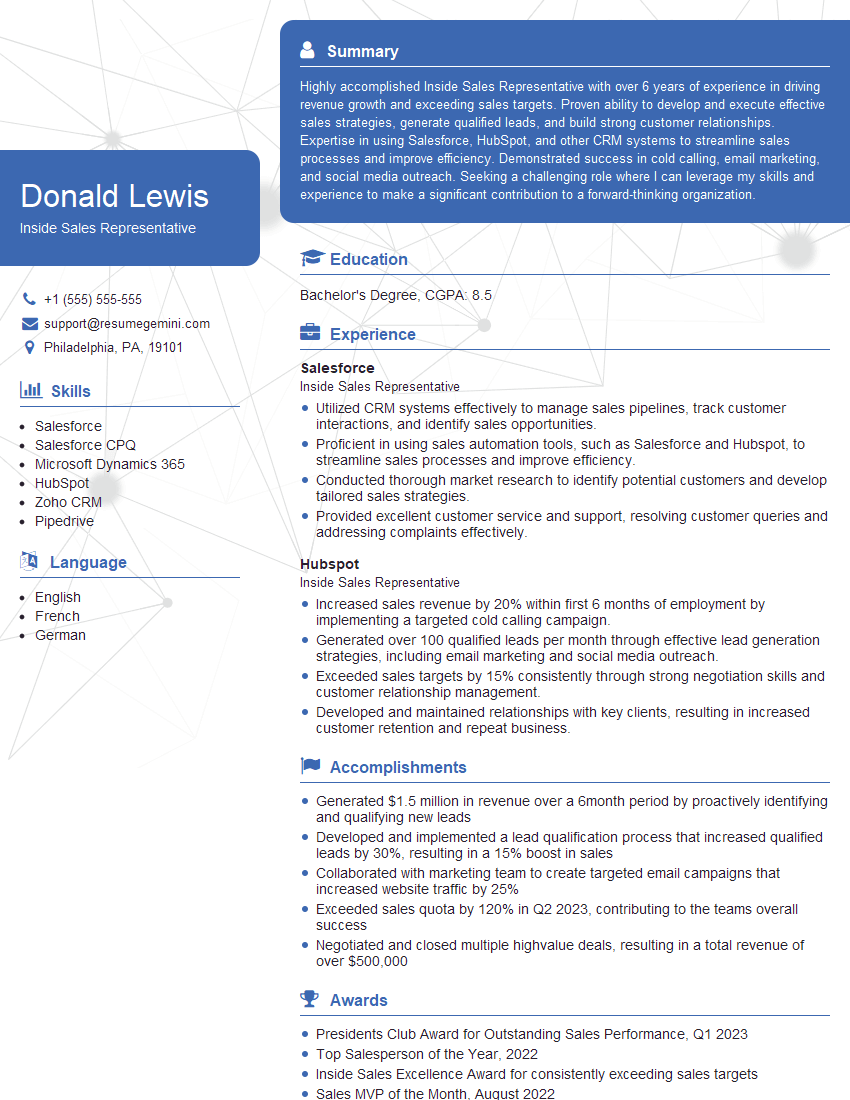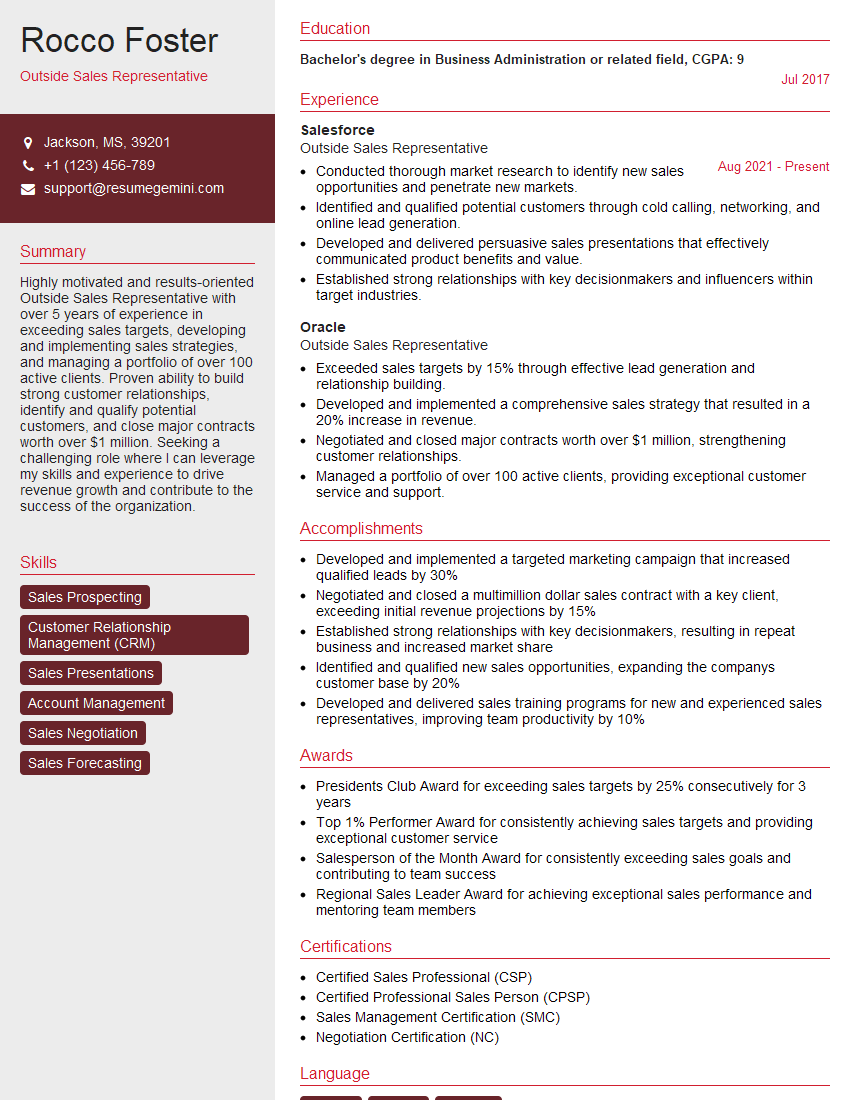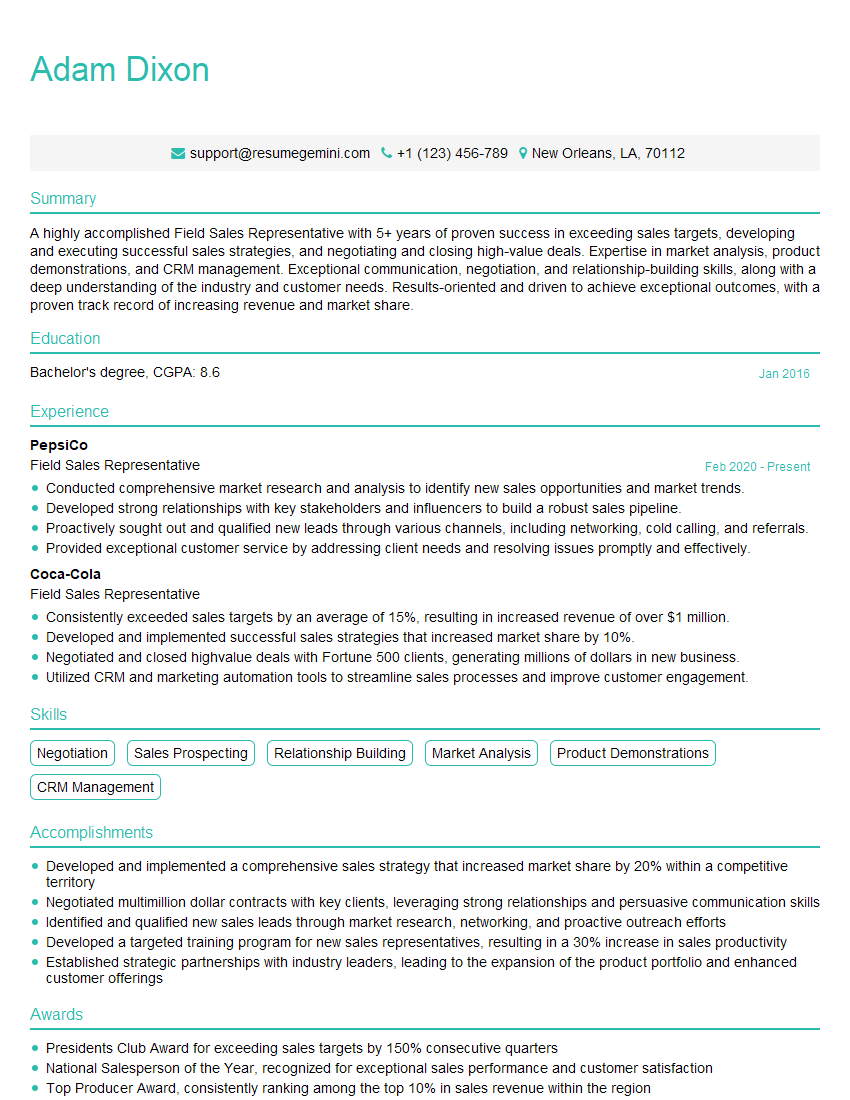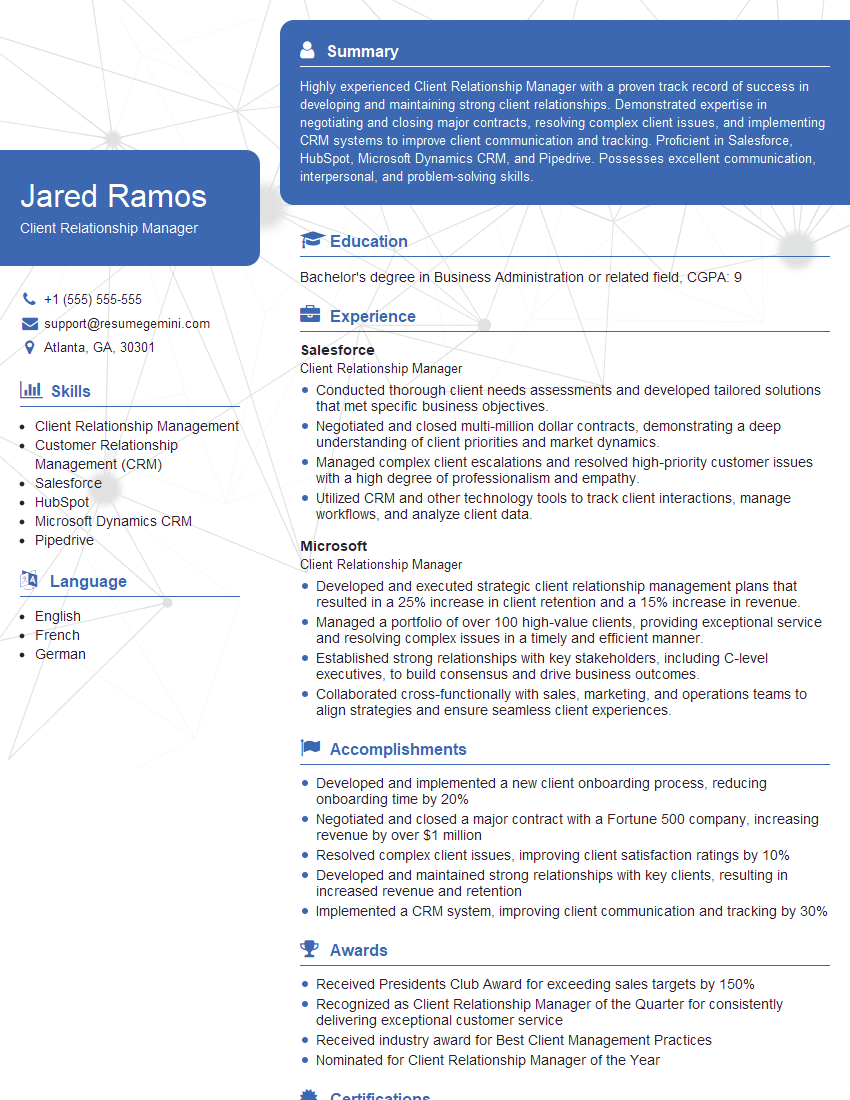Warning: search_filter(): Argument #2 ($wp_query) must be passed by reference, value given in /home/u951807797/domains/techskills.interviewgemini.com/public_html/wp-includes/class-wp-hook.php on line 324
Interviews are opportunities to demonstrate your expertise, and this guide is here to help you shine. Explore the essential Upselling Products/Services interview questions that employers frequently ask, paired with strategies for crafting responses that set you apart from the competition.
Questions Asked in Upselling Products/Services Interview
Q 1. Explain your understanding of upselling and cross-selling.
Upselling and cross-selling are both sales techniques aimed at increasing revenue, but they differ in their approach. Upselling involves persuading a customer to purchase a more expensive or higher-value version of the product or service they are already considering. Think of it as upgrading. Cross-selling, on the other hand, involves suggesting complementary products or services to enhance the customer’s initial purchase. It’s about expanding their purchase.
For example, if a customer is buying a basic laptop, upselling might involve suggesting a model with a larger hard drive and more RAM. Cross-selling might involve offering a laptop bag, extended warranty, or software bundle.
Q 2. Describe a situation where you successfully upselled a product or service. What was your approach?
I once worked with a client interested in a basic website design package. During the consultation, I learned about their ambitious growth plans and their desire to establish a strong online presence. I noticed their initial package lacked key features needed for effective SEO and lead generation. Instead of simply selling the basic package, I presented the premium package which included advanced SEO tools, a content management system (CMS), and professional photography.
My approach involved active listening and asking clarifying questions to understand their business goals. I then showed them a comparative analysis highlighting the benefits and return on investment (ROI) of the premium package, emphasizing how these features would help them achieve their goals faster. The additional cost was easily justified given the significant value added. They ultimately opted for the premium package, resulting in a much higher revenue than initially anticipated.
Q 3. What strategies do you use to identify upselling opportunities?
Identifying upselling opportunities requires a multi-faceted approach. I use several strategies:
- Understanding Customer Needs: Active listening during the initial consultation and sales process is crucial. I aim to understand their current needs, pain points, and future aspirations.
- Analyzing Purchase History: Examining past purchases reveals patterns and preferences, suggesting potential upgrades or complementary products.
- Leveraging Data Analytics: Website analytics and CRM data can identify customers who have shown interest in higher-tier products or features.
- Product Knowledge: A deep understanding of the product range and its features allows me to identify suitable upgrades and match them with customer needs.
- Customer Segmentation: Categorizing customers based on demographics, behaviour, and purchase history allows me to tailor upselling efforts to specific groups.
Q 4. How do you handle objections when upselling?
Handling objections during upselling requires empathy, understanding, and a solution-oriented approach. Instead of directly counteracting the objection, I acknowledge their concern and address it.
- Acknowledge and Validate: I start by acknowledging their concerns, making them feel heard, like “I understand your hesitation about the price increase.”
- Reframe the Objection: I often reframe the objection to highlight the value proposition. For example, if they object to the cost, I might emphasize the long-term savings or ROI the upgrade offers.
- Offer a Compromise: Sometimes, offering a phased approach or a smaller upgrade can make the upsell more palatable.
- Focus on Benefits, not Features: I emphasize how the upgraded product or service will directly solve their problems or improve their lives, rather than just listing features.
Q 5. How do you determine the appropriate upsell for a specific customer?
Determining the appropriate upsell is a critical step. It requires a thorough understanding of the customer and their needs.
- Assess Customer Needs: Based on initial consultations, past purchases, and gathered data, I determine what additional features or benefits would genuinely enhance their experience and solve their problems.
- Consider Budget: I always keep the customer’s budget in mind, avoiding suggesting upgrades they can’t afford.
- Prioritize Value: I prioritize upselling products or services that offer significant value and a clear return on investment.
- Test and Iterate: I continually test different upselling strategies to optimize conversion rates and identify what resonates most with the target audience.
Q 6. What metrics do you use to measure the success of your upselling efforts?
I use several key metrics to track the success of upselling efforts:
- Upsell Conversion Rate: The percentage of customers who purchase a higher-priced item or upgrade after being presented with the upsell opportunity.
- Average Revenue per Customer (ARPU): A key metric that measures the average revenue generated per customer, reflecting the impact of upselling on overall revenue.
- Upsell Revenue: The total revenue generated specifically from upselling activities.
- Customer Lifetime Value (CLTV): Measuring the total revenue a customer generates throughout their relationship with the business. Upselling often significantly impacts this metric.
Q 7. Describe your process for qualifying leads for upselling.
Qualifying leads for upselling involves identifying customers who are most likely to respond positively to an upsell offer.
- Engagement Level: Customers who have actively engaged with the product or service, expressed interest in additional features, or shown a high level of satisfaction are prime candidates.
- Purchase History: Customers with a history of making purchases or using a specific product/service are more likely to be receptive to upgrades.
- Customer Feedback: Positive reviews, testimonials, and feedback indicate customer satisfaction and a potential interest in premium features.
- Website Behavior: Customers who have visited pages related to higher-tier products or features often show implicit interest in upgrading.
I often use a scoring system that assigns points based on these criteria, making it easier to prioritize leads and focus upselling efforts on those most likely to convert.
Q 8. How do you maintain a positive customer relationship while upselling?
Maintaining positive customer relationships during upselling is paramount. It’s not about pushing a sale, but about adding value. Think of it as a helpful suggestion, not a hard sell. This requires a genuine focus on the customer’s needs and understanding their current situation.
- Active Listening: Truly listen to the customer’s concerns and preferences. What are their pain points? What are their goals? This information guides your upselling suggestions.
- Empathy and Understanding: Put yourself in the customer’s shoes. Would you find this upsell valuable? If not, then it’s probably not the right fit.
- Transparency and Honesty: Be upfront about the benefits and limitations of the upsell. Don’t make false promises or exaggerate the features.
- Building Rapport: Establish a connection with the customer. A friendly and professional demeanor goes a long way. Use their name and show genuine interest in their needs.
- Value Proposition: Clearly articulate how the upsell solves a problem or improves their experience. Focus on the value it provides, not just the price.
For example, instead of saying “Would you like to upgrade to our premium plan for an extra $20?”, you could say, “Based on your usage, I noticed our premium plan offers unlimited storage which might significantly improve your workflow and save you time in the long run.” This focuses on the benefit, not just the cost.
Q 9. How do you adapt your upselling approach to different customer personalities?
Adapting your upselling approach to different customer personalities is crucial for success. Different people respond to different communication styles.
- Analytical Customers: These customers need data and facts. Present them with clear comparisons, statistics, and ROI calculations to demonstrate the value of the upsell.
- Decisive Customers: These customers make quick decisions. Present your upsell options concisely and clearly, highlighting the key benefits. Don’t overwhelm them with too much information.
- Friendly Customers: Build rapport with these customers. Engage in friendly conversation, be approachable, and let them lead the conversation. The upsell should feel natural and not forced.
- Cautious Customers: These customers need reassurance. Address their concerns directly, provide testimonials or case studies, and offer a money-back guarantee or trial period.
Imagine you’re upselling a software subscription. For an analytical customer, you’d emphasize the increased efficiency and cost savings. For a cautious customer, you’d highlight the risk-free trial and positive customer reviews.
Q 10. What are some common mistakes to avoid when upselling?
Avoiding common mistakes in upselling is key to maintaining customer trust and maximizing revenue.
- Poor Timing: Upselling at the wrong moment, such as when a customer is already frustrated or stressed, can negatively impact the experience.
- Lack of Value Proposition: Failing to clearly demonstrate the value of the upsell to the customer. Just stating the price without explaining the benefit is a major mistake.
- Aggressive Sales Tactics: High-pressure selling tactics can alienate customers and damage your reputation.
- Irrelevant Upsells: Offering upsells that don’t meet the customer’s needs or align with their current purchase is wasteful and ineffective.
- Ignoring Customer Signals: Failing to recognize when a customer is not interested in an upsell and continuing to push it.
For example, imagine offering an expensive add-on to a customer who has already expressed budget constraints. This would be an irrelevant and potentially damaging upsell.
Q 11. How do you handle a situation where a customer declines an upsell?
When a customer declines an upsell, it’s crucial to handle the situation gracefully. The goal is to maintain the relationship, even if the sale is lost.
- Respect their Decision: Acknowledge their decision without pressure or judgment. A simple “I understand” goes a long way.
- Reiterate Value: Briefly restate the benefits of the upsell to leave a positive impression, even if they decline.
- Offer Alternatives: If appropriate, suggest alternative options that may better suit their needs and budget.
- Maintain Contact: Keep the lines of communication open. Let them know you’re available if they change their mind or have further questions.
- Learn from the Interaction: Analyze why the customer declined the upsell. This can help improve your future upselling strategies.
Instead of pushing further, you could say, “I understand. Our premium plan does offer significant value, but I respect your decision. If you ever change your mind, feel free to reach out.”
Q 12. What is your understanding of the ethical considerations involved in upselling?
Ethical considerations are crucial in upselling. The primary focus should always be on the customer’s best interests, not solely on increasing sales figures.
- Transparency: Be completely transparent about the product or service being upsold, including its features, pricing, and limitations. Avoid misleading or deceptive tactics.
- No Pressure: Never pressure a customer into purchasing an upsell. Their decision should be voluntary and based on their own assessment of value.
- Customer Needs First: Prioritize the customer’s needs and goals over your own sales targets. Only suggest upsells that genuinely benefit them.
- Avoid Misrepresentation: Don’t exaggerate the benefits or downplay the drawbacks of an upsell.
- Data Privacy: Handle customer data responsibly and ethically. Don’t use their information in a way that violates their privacy.
An ethical upsell focuses on providing added value and enhancing the customer experience, not on exploiting them for profit. The long-term health of the customer relationship is more valuable than a single sale.
Q 13. How do you handle pressure to meet upselling targets?
Handling pressure to meet upselling targets requires a balanced approach that prioritizes ethical practices and customer satisfaction.
- Focus on Value, Not Targets: Shift your mindset from solely meeting targets to focusing on delivering value to customers. If you provide genuine value, sales will often follow.
- Effective Training and Resources: Ensure you have the necessary training and resources to effectively upsell without resorting to manipulative tactics.
- Open Communication: Communicate honestly with your manager about realistic targets and challenges you face in achieving them.
- Data-Driven Approach: Track your upselling performance using data. This will help you identify areas for improvement and make adjustments to your approach.
- Prioritize Customer Relationships: Remember that building long-term customer relationships is more valuable than short-term sales gains. A dissatisfied customer is bad for business.
For example, if targets are unrealistic, discuss this with your manager, proposing adjustments or changes to the sales process. Focus on consistently improving your techniques and providing value. The targets will follow naturally.
Q 14. How do you stay up-to-date on industry trends relevant to upselling?
Staying current with industry trends in upselling is vital for success. The landscape is constantly evolving.
- Industry Publications and Blogs: Read trade publications and industry blogs to keep abreast of new strategies, techniques, and best practices.
- Conferences and Webinars: Attend industry conferences and webinars to learn from experts and network with peers.
- Competitor Analysis: Study your competitors’ upselling strategies to identify opportunities for improvement and innovation.
- Customer Feedback: Actively solicit and analyze customer feedback to identify areas where your upselling efforts can be improved.
- Data Analytics: Use data analytics to track your upselling performance and identify areas where you can optimize your approach.
By consistently engaging with these resources, you will stay ahead of the curve and adapt your upselling strategies accordingly. This ensures your techniques remain effective and relevant in the dynamic market.
Q 15. What are some effective upselling techniques for different sales channels (e.g., phone, email, in-person)?
Effective upselling hinges on understanding the customer’s needs and presenting solutions that address those needs, going beyond their initial purchase. The approach varies across sales channels:
- Phone: Active listening is key. After confirming the initial order, I’d ask open-ended questions like, “What are your primary goals with this product?” or “How do you envision using this in your daily workflow?” This allows me to identify opportunities for upsells. For example, if they’re buying a basic software license, I might suggest a premium version with advanced features or priority support based on their stated goals. I would also offer limited-time discounts or bundles to incentivize the upgrade.
- Email: Targeted email campaigns are powerful. Segmentation is crucial; I’d segment customers based on purchase history, engagement levels, and demographics to offer relevant upsells. For instance, I might send an email to customers who purchased a specific product suggesting a complementary accessory or add-on. A strong call to action and compelling visuals are essential. A/B testing different subject lines and email copy is crucial to optimize conversion rates.
- In-Person: Building rapport is paramount. I’d engage in friendly conversation, asking questions to understand their needs and pain points. Demonstrations are incredibly effective – I might showcase the benefits of a higher-tier product directly, highlighting features that address specific challenges they’ve mentioned. Offering a trial period or money-back guarantee can allay concerns and increase confidence in the upsell.
In all channels, framing the upsell as a solution to a problem, rather than just an added expense, is critical. For example, instead of saying “Would you like to upgrade?”, I might say, “To maximize your efficiency with this software, our premium version offers feature X, which can save you Y amount of time per week.”
Career Expert Tips:
- Ace those interviews! Prepare effectively by reviewing the Top 50 Most Common Interview Questions on ResumeGemini.
- Navigate your job search with confidence! Explore a wide range of Career Tips on ResumeGemini. Learn about common challenges and recommendations to overcome them.
- Craft the perfect resume! Master the Art of Resume Writing with ResumeGemini’s guide. Showcase your unique qualifications and achievements effectively.
- Don’t miss out on holiday savings! Build your dream resume with ResumeGemini’s ATS optimized templates.
Q 16. How do you use technology to support your upselling efforts?
Technology plays a vital role in streamlining and optimizing my upselling efforts. I leverage several tools:
- CRM Systems (e.g., Salesforce, HubSpot): These systems provide a centralized view of customer interactions, purchase history, and preferences. This allows me to identify upselling opportunities based on data-driven insights. I can segment customers, track campaign performance, and personalize upsell offers accordingly.
- Marketing Automation Platforms (e.g., Marketo, Pardot): These platforms automate email marketing campaigns, making it efficient to reach out to targeted customer segments with relevant upsell offers at the right time. I can create automated workflows that trigger emails based on specific customer behaviors or purchase events.
- Product Recommendation Engines: These engines analyze customer data to suggest relevant products or services. This can be integrated into websites or e-commerce platforms, providing personalized upsell recommendations at the point of purchase.
- Analytics Dashboards: Real-time data dashboards provide insights into campaign performance, allowing me to adjust my strategies as needed to maximize conversion rates. Tracking key metrics like conversion rates, average order value, and customer lifetime value helps me refine my upselling process.
For example, using a CRM, I might identify customers who purchased a basic plan and haven’t used a key feature in the premium plan. I can then proactively reach out to those customers with a tailored upsell offer highlighting the unused feature and its benefits.
Q 17. How do you differentiate between upselling and cross-selling in your sales process?
Upselling and cross-selling are distinct but related sales strategies. Upselling involves encouraging a customer to purchase a higher-tier product or a more expensive version of the product they are already buying. It’s about increasing the value of the initial transaction. Cross-selling, on the other hand, involves suggesting complementary products or services that enhance or supplement the customer’s original purchase.
In my sales process, I differentiate them by carefully considering the customer’s needs. If a customer is looking for a more feature-rich solution or a higher level of service, that’s an upselling opportunity. If they’re interested in accessories, add-ons, or related items that complement their purchase, that’s cross-selling.
For example, a customer buying a basic camera might be up-sold to a more advanced model with superior features. That same customer might be cross-sold a camera bag, extra lenses, or a memory card. I carefully choose which strategy to use depending on the context and the customer’s individual needs.
Q 18. Describe your experience using sales CRM systems for upselling.
Sales CRM systems are indispensable for effective upselling. I use them to:
- Identify high-potential customers: By analyzing customer data, I can identify individuals most likely to be receptive to upsells based on their purchase history, engagement levels, and other relevant factors. This allows me to prioritize my efforts and focus on the most promising opportunities.
- Track sales interactions: The CRM logs all interactions with customers, providing a complete history of conversations, emails, and other communications. This ensures that I can always approach customers with relevant information based on previous interactions and avoid unnecessary repetition.
- Personalize upsell offers: CRM systems allow for personalized communication by incorporating customer data into upsell pitches. This makes the upsell feel more relevant and less like a generic sales tactic.
- Manage upsell campaigns: I can use the CRM to track the performance of upsell campaigns, analyzing key metrics to identify areas for improvement and optimize my strategies.
For instance, if a customer recently showed interest in a particular feature that is only available in a higher-tier plan, the CRM will alert me, allowing me to follow up with a timely and personalized upsell offer. This data-driven approach maximizes efficiency and effectiveness.
Q 19. How do you prioritize upselling opportunities?
Prioritizing upselling opportunities is critical to maximizing efficiency. My approach uses a multi-faceted strategy:
- Customer segmentation: I segment customers based on factors like purchase history, engagement, and demographics. This allows me to identify customers most likely to be receptive to upsells.
- Value-based prioritization: I focus on customers who have already invested significantly in our products or services. They are typically more likely to invest further.
- Product fit: I prioritize opportunities where the upsell directly addresses a customer’s expressed needs or pain points. This ensures a more relevant and successful pitch.
- RFM Analysis (Recency, Frequency, Monetary value): This analytical technique helps identify customers who have recently purchased, frequently purchased, and spent the most money. These are often prime candidates for upselling.
I use a scoring system to rank potential upsell opportunities, considering these factors. This ensures I dedicate my time and resources to the most promising leads, optimizing my upselling efforts.
Q 20. How do you overcome price objections when upselling?
Price objections are common when upselling. Addressing them effectively requires a strategic approach:
- Quantify the value: Instead of focusing solely on the price increase, I highlight the value proposition of the higher-tier product or service. I focus on the return on investment (ROI) – how the upsell will save time, increase efficiency, or generate more revenue.
- Highlight the benefits, not just features: I connect the features of the upsell to the customer’s specific needs and goals, demonstrating how they will directly address those needs.
- Offer financing options: If the price is a significant barrier, I explore payment plans or financing options to make the purchase more manageable.
- Frame the upsell as an investment, not an expense: By focusing on the long-term benefits and potential returns, I reposition the price as an investment in the customer’s success.
- Use testimonials or case studies: Sharing success stories of other customers who have benefited from the upsell can build confidence and demonstrate the value proposition.
For example, instead of saying “The upgrade costs an extra $100,” I might say, “The premium version saves you an estimated 10 hours per week, leading to a significant increase in productivity. Considering your hourly rate, that’s a return on investment of X within Y months.”
Q 21. How do you build rapport with customers to facilitate successful upselling?
Building rapport is crucial for successful upselling. It establishes trust and makes the customer more receptive to suggestions.
- Active listening: I pay close attention to what the customer says, both verbally and non-verbally. This allows me to understand their needs, concerns, and preferences, enabling me to tailor my upsell pitch to their specific situation.
- Empathy and understanding: I try to see things from the customer’s perspective and show genuine concern for their needs. This creates a connection and builds trust.
- Personalized communication: I avoid generic sales pitches and instead focus on addressing the customer’s unique needs and challenges. This makes the upsell feel more relevant and less like a pushy sales tactic.
- Building a relationship: I aim to build a long-term relationship with the customer, not just close a single sale. This fosters loyalty and creates opportunities for future upsells.
For instance, if a customer expresses frustration with a particular aspect of their current product, I might highlight how the higher-tier version addresses this specific issue, showing that I understand their concerns and am providing a solution.
Q 22. How do you present the value proposition of an upsell effectively?
Effectively presenting an upsell’s value proposition hinges on clearly demonstrating the additional benefit to the customer. It’s not about pushing a sale; it’s about showing how the upsell solves a problem or enhances their existing purchase. I achieve this through a three-pronged approach:
- Highlighting the added value: Instead of focusing on price, I emphasize the features and benefits. For example, instead of saying “This upgrade costs $50 more,” I’d say, “For an additional $50, you’ll unlock unlimited storage and priority customer support, saving you time and frustration.”
- Using strong storytelling: I connect the upsell to the customer’s needs and goals. This might involve sharing a success story of a previous customer who benefited significantly from the upgrade or painting a picture of how the upsell enhances their experience.
- Providing clear and concise information: I avoid technical jargon and use simple language that’s easy for the customer to understand. I also make sure to address potential questions or objections proactively.
For example, if selling photo editing software, instead of just offering a higher tier subscription, I’d emphasize the increased storage, advanced features like noise reduction or batch processing, and the time saved which translates to cost savings and increased efficiency. I’d also explain how these features help them create higher-quality, more professional-looking photos, directly addressing their underlying need.
Q 23. What is your approach to addressing customer concerns about the value of an upsell?
Addressing customer concerns about the value of an upsell requires active listening and empathy. I begin by acknowledging their concerns, then proceed to address them directly, using a consultative approach. Here’s my process:
- Active listening: I carefully listen to the customer’s concerns without interruption, demonstrating that their perspective is valued.
- Emphasizing the ROI: I focus on the return on investment (ROI) the customer will receive. This often involves quantifying the benefits. For instance, “This upgrade will save you an estimated 10 hours per month on administrative tasks.”
- Offering a trial period or guarantee: If possible, I’ll offer a trial period or a money-back guarantee to alleviate the customer’s risk and build trust.
- Comparison: If appropriate, I compare the cost and features of the upsell against the base offering or against competitor products, showcasing the superior value.
For instance, if a customer expresses concern about the price of a premium support package, I’d counter by pointing out that it includes guaranteed response times, direct access to a dedicated expert, and potentially significant cost savings from avoiding prolonged troubleshooting themselves.
Q 24. How do you track your upselling performance and identify areas for improvement?
Tracking upselling performance and identifying areas for improvement requires a robust system for data collection and analysis. I use a combination of quantitative and qualitative methods:
- Key Performance Indicators (KPIs): I monitor key metrics such as upsell conversion rate, average upsell value, and revenue generated from upselling. These metrics are tracked through our CRM and sales dashboards.
- A/B testing: I regularly test different upselling approaches (e.g., different messaging, timing, or offers) to determine what resonates best with customers.
- Customer feedback: I collect customer feedback through surveys, reviews, and direct conversations to understand their perceptions of the upselling process and identify areas for improvement. I utilize CRM feedback tools and post-purchase surveys.
- Sales call recordings/reviews: Analyzing sales call recordings helps identify successful and unsuccessful strategies, allowing for refinement of the upselling process.
By analyzing these data points, I can identify patterns, pinpoint areas where the process falls short, and implement data-driven changes to optimize our upselling strategy. For example, if the conversion rate for a particular upsell is low, I might adjust the messaging or offer a different incentive.
Q 25. How do you handle situations where the customer is already considering a competitive product?
When a customer is considering a competitive product, I use a comparative approach, focusing on the unique advantages of our offering. The key is not to badmouth the competitor but to highlight the value proposition of our product/service.
- Acknowledge the competition: I begin by acknowledging the customer’s interest in the competitor’s product, demonstrating respect for their decision-making process.
- Highlight our strengths: I then focus on the unique aspects of our offering that differentiate us from the competition, such as superior customer service, innovative features, or a more favorable pricing structure. I create a clear comparison chart to illustrate the distinctions.
- Address specific concerns: I directly address any concerns the customer might have about our product in relation to the competitor. If the competitor’s product has a specific strong point, I might offer a similar advantage or emphasize areas where we are demonstrably better.
- Focus on customer needs: I reiterate the customer’s specific needs and explain how our product or upsell better addresses those needs than the competitor’s product.
For example, if the competitor offers a lower price, I’d highlight the superior quality of our product, the better customer support, or the longer warranty that justifies the price difference. The focus remains on showing how we better meet their needs, not just on being cheaper.
Q 26. What is your understanding of the customer’s lifetime value in relation to upselling?
Customer Lifetime Value (CLTV) is crucial in upselling. A higher CLTV indicates a customer is likely to generate more revenue over their relationship with the company. Upselling is a key strategy to increase CLTV. By offering relevant upgrades and add-ons, we cultivate customer loyalty and encourage repeat purchases. It’s not just about the immediate upsell revenue; it’s about building a long-term relationship with the customer.
Understanding CLTV helps us prioritize which customers to target for upselling efforts. We may focus more on high-CLTV customers who demonstrate high engagement and loyalty, offering them premium upsells designed to further enhance their experience and increase their overall spend. Conversely, lower-CLTV customers might be offered more basic upsells, focusing on increasing their engagement and potentially moving them towards higher-value offerings in the future.
Effectively, maximizing CLTV through strategic upselling fosters sustainable business growth by building strong, profitable relationships with our most valuable customers.
Q 27. How would you handle a difficult customer who is resistant to upselling?
Handling a resistant customer requires patience, empathy, and a shift in approach. It’s crucial to understand the root cause of their resistance – is it price, perceived value, or something else entirely?
- Acknowledge their concerns: Begin by acknowledging their concerns and validating their feelings. A simple, “I understand your hesitation,” can go a long way.
- Reframe the value proposition: Instead of directly pushing the upsell, focus on how the features solve their problems or enhance their current experience. Offer real-world examples or testimonials.
- Offer alternatives: Suggest a smaller, less expensive upsell or a trial period to alleviate their concerns about risk.
- Let them think: Avoid pressuring them. Sometimes, simply providing the information and giving the customer space to consider their options leads to a positive outcome.
- Respect their decision: If, despite your best efforts, they remain unconvinced, respect their decision. Maintain a positive relationship for future opportunities.
Ultimately, building rapport and understanding their needs are paramount. A pushy approach is counterproductive; a consultative approach, focusing on their individual circumstances, is far more likely to lead to a successful upsell (or at least to maintaining the customer relationship).
Q 28. Describe a time you successfully negotiated an upsell.
I recently worked with a small business owner who purchased our basic marketing automation software. They were initially hesitant about upgrading to our premium package, citing budget constraints. However, during our conversation, I discovered they were struggling to manage their email marketing campaigns efficiently, spending considerable time on manual tasks.
Instead of focusing on the price difference, I demonstrated how the premium package’s automated workflows and advanced analytics would save them an estimated 10-15 hours per week – time they could spend on other crucial aspects of their business. I also presented a case study showing how a similar business increased their conversion rate by 20% using those features. I offered a customized payment plan to address their budget concerns.
By focusing on the time savings and ROI, rather than just the cost, I was able to successfully negotiate the upsell, building a stronger relationship with the client while simultaneously demonstrating the true value of our premium offering. They were thrilled with the results and became a loyal, high-value customer.
Key Topics to Learn for Upselling Products/Services Interview
- Understanding Customer Needs: Identifying customer pain points and aligning product/service benefits to address those needs effectively. This includes active listening skills and needs-based questioning techniques.
- Value Proposition Articulation: Clearly and concisely communicating the added value of upselling options, emphasizing ROI and long-term benefits for the customer. Practice crafting compelling narratives.
- Objection Handling: Developing strategies to effectively address customer objections and concerns regarding price, features, or perceived value. Role-playing can be invaluable here.
- Sales Techniques & Strategies: Mastering various sales methodologies relevant to upselling, such as consultative selling, feature-benefit selling, and building rapport.
- Ethical Considerations: Understanding and adhering to ethical guidelines in upselling. Ensuring transparency and avoiding high-pressure tactics. Focusing on genuine customer benefit.
- Metrics & Measurement: Understanding key performance indicators (KPIs) related to upselling success, such as conversion rates, average revenue per customer (ARPU), and customer lifetime value (CLTV).
- Product Knowledge: Demonstrating a thorough understanding of the products or services you’d be upselling, including features, benefits, pricing, and limitations.
- Building Relationships: Highlighting your ability to build strong customer relationships based on trust and mutual understanding. This is crucial for successful upselling.
Next Steps
Mastering the art of upselling products and services is crucial for career advancement in sales and related fields. It demonstrates your ability to drive revenue, enhance customer satisfaction, and contribute significantly to business growth. To maximize your job prospects, focus on creating a compelling and ATS-friendly resume that highlights your relevant skills and achievements. ResumeGemini is a trusted resource to help you build a professional and effective resume that showcases your expertise. Examples of resumes tailored to Upselling Products/Services are available to further guide your preparation.
Explore more articles
Users Rating of Our Blogs
Share Your Experience
We value your feedback! Please rate our content and share your thoughts (optional).
What Readers Say About Our Blog
Hi, I represent a social media marketing agency that creates 15 engaging posts per month for businesses like yours. Our clients typically see a 40-60% increase in followers and engagement for just $199/month. Would you be interested?”
Hi, I represent an SEO company that specialises in getting you AI citations and higher rankings on Google. I’d like to offer you a 100% free SEO audit for your website. Would you be interested?
